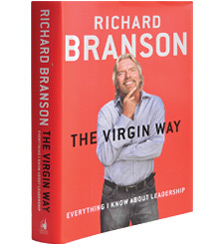Best Business Books 2015: Leadership
Leading by Biographical Example
A version of this article appeared in the Winter 2015 issue of strategy+business.
George Bodenheimer (with Donald T. Phillips)
Every Town Is a Sports Town: Business Leadership at ESPN, from the Mailroom to the Boardroom (Grand Central Publishing, 2015)
Richard Branson
The Virgin Way: Everything I Know about Leadership (Portfolio/Penguin, 2014)
Daniel Lubetzky
Do the Kind Thing: Think Boundlessly, Work Purposefully, Live Passionately (Ballantine, 2015)
According to the late Warren Bennis, leaders are molded in “the crucible of experience.” Presumably, then, those who have emerged successfully from that fiery process (metaphorically speaking) are the best equipped to offer advice on how to lead. At least that’s what the book-buying public seems to conclude, as it clamors for leadership books penned by prominent businesspeople. Those ever-popular volumes fall into two general categories: memoirs by executives in the context of the organizations they led, and “how-to” manuals based on what executives have learned about leadership. In my view, the former tend to be far superior to the latter.
This year’s crop of leadership tomes offers examples in both categories. While none stands out as an absolute must-read, to paraphrase former defense secretary Donald Rumsfeld, you go to press with the authors you have, not the authors you might want. So here are my picks for this year’s best books by leaders on leadership.
The Network Executive
For my money — and I am surprised by my own conclusion — the best current leadership book is George Bodenheimer’s Every Town Is a Sports Town: Business Leadership at ESPN, from the Mailroom to the Boardroom. Before picking up the book, I had never heard of Bodenheimer (he was the longtime behind-the-scenes head of television sports network ESPN) and seldom watched anything broadcast on his network. But I suspect that even readers who watch only Masterpiece Theatre and don’t know an RBI from an ERA will find the book a worthy and engaging read. That’s because its author comes across as a thoughtful, caring, humble, and wise executive. Indeed, Bodenheimer seems like the kind of leader most of us would follow willingly.
The book falls squarely in the memoir category. It begins with the author’s first day at the fledgling network in 1979 (where he literally worked in the mailroom), then takes us through the development of all phases of the business over the next 35 years, ending with his retirement as cochairman of Disney Media Networks. (ESPN’s parent company, ABC, was acquired by Disney in 1995, midway through his tenure.) Refreshingly, Bodenheimer doesn’t presume to be an authority on leadership; he never succumbs to telling others how they ought to lead. Instead, he simply and clearly describes what he and his colleagues did over the years, the good, the bad, and — hey, ESPN is in the entertainment business! — even the silly of leadership. (At ESPN “crises” sometimes consisted of deciding whether to air or bleep out basketball coach Bobby Knight dropping “thirty-one F-bombs.”) In essence, we observe Bodenheimer maturing in Bennis’s crucible, gradually becoming a leader by analyzing what his bosses do right and do wrong over the years, and by learning from his own experience. For example, he came to understand that the way to develop young leaders was to put them in deep water and trust them to figure out how to swim to safety.
The book deals with all facets of business leadership: developing strategy, changing business models, encouraging innovation, creating organizational structure, motivating others, understanding the nitty-gritty of sales, dealing with outsized egos (imagine managing the likes of mercurial host Keith Olbermann), planning for globalization, coping with mergers and acquisitions, and, in particular, shaping corporate culture. These essential tasks of leadership are realistically presented in the context of the ESPN organization — that is, leadership is not treated as a theoretical abstraction, a personality trait, or a set of rules or best practices. And that’s as it should be, because no one is a leader when working alone. Instead, people become leaders in the context of organizations or when dealing with challenges that require the coordinated efforts of others. Because every action Bodenheimer takes, and every decision he makes, is in the context of leading ESPN, readers can see clearly — and assess for themselves — the practical value and validity of what he describes.
Readers are unlikely to discover anything groundbreaking in Bodenheimer’s book. Instead, they will find countless practical examples of how one leader applies state-of-the-art thinking about leadership. We see him practicing what many experts today preach: listening carefully to employees, learning purposefully from mentors, delegating authority, building cohesive teams, creating and reinforcing a people-centered culture, fostering innovation, building stakeholder relationships, coaching micromanagers to trust their people, engaging in constant and candid communication, and focusing on profitable growth. Through it all, he drives home his primary tenet: “Leadership is about people.”
The Startup Master
The Virgin Way: Everything I Know about Leadership, by Richard Branson, falls into the “how to” category. Branson, recognizable for his majestic mane and ready smile, comes across as a sensible, thoughtful, and rather charming chap (albeit markedly less humble than Bodenheimer). The self-made billionaire offers sound leadership advice, much of which jibes with Bodenheimer’s emphasis on the importance of listening, delegating, and nurturing teamwork and people-oriented corporate cultures. But Branson, a serial entrepreneur who has created lasting businesses in telecommunications, music, air travel, and financial services, appears to have learned more about organizational leadership through research (undertaken, I suspect, by an uncredited ghostwriter) than in the crucible of experience. That’s unfortunate, because the book is absorbing when Branson, one of the more interesting characters in modern business, draws lessons from his own successes and failures. Surprisingly, the preponderance of examples he cites are about others, many of whom may be overly familiar to business readers (do we really need to hear again about Steve Jobs’s Jekyll and Hyde personality?).Although much of what Branson says about operational leadership feels secondhand — in fact, he admits to having had little day-to-day managerial experience — he has mastered the ins and outs of entrepreneurship. Thus, when he turns to his own considerable experience with business startups halfway through the book, the advice becomes compelling, credible, and useful. His chapter “Big Dogfights” vividly brings to life how entrepreneurs think and act, offering practical, strategic insights about reducing risk when entering established markets (two hints: take on lumbering Goliaths like British Air, and don’t waste dough on advertising).
Branson is candid about the reasons for his failures, including Virgin Cola (he failed to realize how hard it was to overcome Coca-Cola’s brand advantage) and Virgin Megastores (he didn’t anticipate the rapid rise of new media). He also draws useful lessons from near disasters (Goldman Sachs tried to rush Virgin into buying a bundle of subprime mortgages). From the latter, he concludes that “orchestrated procrastination” is often wiser than the “decisive” — read “instinctively impulsive” — leadership style so many entrepreneurs relish practicing.
Branson personifies a type of leadership that many corporate veterans might find hard to emulate. Soon after launching any new venture, he turns it over to someone else to run. By necessity, then, hiring the right talent is his first priority. Branson doesn’t look to employ administrators; instead, he wants everyone who works for him also to be entrepreneurial, while more skilled at management than he is. His troops are granted great leeway to run their businesses; they are free from restrictive controls, short-term profit targets, and rules in general (Branson’s mantra: “Change the policy — to no policy”). He writes of his people, “on occasions too numerous to recall, I have often paused to wonder just who was leading who on any particular project.” But he concludes that it didn’t matter even if he was the one being led, as long as the job was getting done. Branson also waxes eloquent on the subject of creating robust corporate cultures, which he likens to coral reefs: “They both take a long time to grow…and they are a fragile living entity that if abused can be destroyed very easily and quickly.”
Branson reveals a side of his personality that is less well known (and more admirable): passionate advocacy of “social enterprises.”
Most readers know Branson thanks to one or another of the well-orchestrated stunts he has personally pulled to garner publicity for Virgin products, such as driving a Sherman tank into Times Square and pretending to fire away at Coke’s iconic sign. However, in these pages Branson reveals a side of his personality that is less well known (and more admirable): passionate advocacy of “social enterprises.” Although not himself a social entrepreneur, he has established centers in Jamaica and South Africa to support men and women in the developing world who want to start businesses that both create needed jobs and provide goods and services that foster community development. He encourages social enterprises in advanced economies as well, claiming there are 70,000 such organizations in the U.K. — a figure that, if overstated, is nonetheless indicative of a major global trend. Moreover, he argues that large, established corporations like his own need to hop on this new wave and engage in ethical “good business” practices. To that end, he boasts that Virgin is a founding organizer of “the B Team,” a consortium of prominent business leaders “in search of a Plan B for business that balances the pursuit of enterprise with the needs of societies and the environment.” Given his prodigious energy, he just might pull that off.
The Social Entrepreneur
Social enterprises such as those Branson advocates have existed in one form or another since the 1970s — think of Ben & Jerry’s, Patagonia, the Body Shop, and Tom’s of Maine. Nonetheless, Daniel Lubetzky’s Do the Kind Thing: Think Boundlesslessly, Work Purposefully, Live Passionately may be the first how-to leadership book specifically aimed at social entrepreneurs. Lubetzky, founder and CEO of Kind, a company that makes snacks marketed as healthy, articulates an important central message: Business leaders need to start thinking in terms of “and” and not “or.” In other words, given the world’s manifold social and environmental problems, companies can no longer operate under the assumption that they can, or must, choose between doing good and doing well. From now on, they’ll have to do both. That argument is far from original, but Lubetzky illustrates how he applied it to the challenge of creating a business of making snacks that are “both healthy and tasty, convenient and wholesome, economically sustainable and socially impactful.”
Like Bodenheimer and Branson, Lubetzky stresses the need for leaders to create human-centered cultures, and to build trust in their organizations. But he adds a new dimension to the topic by dealing with two central and important concepts the other authors ignore: ethical transparency and employee ownership. Lubetzky earns creativity kudos for choosing to package all his products in clear wrappers to symbolize the company’s openness to sharing almost everything about its products and practices with its stakeholders. Unfortunately, he is not fully transparent himself about Kind’s internal workings. He neglects to report the percentage of employee ownership of his company. That’s an important issue, because sharing wealth with employees is one of the most complicated practical issues entrepreneurs face, as well as being a major ethical challenge (witness the mess Gravity Payments’ Dan Price made of the noble goal of paying all his people at least US$70,000 a year).
Lubetzky has an oddly corporate background for an entrepreneur, having been a lawyer at Sullivan & Cromwell and a McKinsey consultant. Nonetheless, I believe budding social entrepreneurs, most of whom find such establishment firms anathema, will relate to his message and find the book inspiring and useful. At times, Lubetzky succumbs to the memoirist’s temptation to assume that both his experience and the insights he proffers are more unusual and profound than they actually are (“Empathy…is a vital if underrated leadership skill”). Also, I must disclose that the copy of the book I was sent for review came with a generous sample of his products. Since my conscience would not allow me to consume them, I did the ethical thing and gave them to my family. They have asked me to report that they enjoyed the snacks immensely.
Reprint No. 00375
Author profile:
- James O’Toole is director of the Neely Center for Ethical Leadership at the University of Southern California’s Marshall School of Business.




